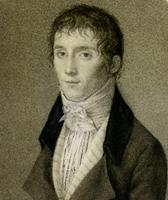Nicéphore Niépce
| Joseph Nicéphore Niépce | |
|---|---|

Nicéphore Niépce, circa 1795.
|
|
| Born |
7 March 1765 Chalon-sur-Saône, Saône-et-Loire |
| Died | 5 July 1833 (aged 68) Saint-Loup-de-Varennes, Saône-et-Loire |
| Occupation | Inventor |
| Known for |
Photography The world's first 'internal combustion engine' |
| Signature | |
 |
|
Nicéphore Niépce (born Joseph Niépce; 7 March 1765 – 5 July 1833) was a French inventor, now usually credited as the inventor of photography and a pioneer in that field. Niépce developed heliography, a technique he used to create the world's oldest surviving product of a photographic process: a print made from a photoengraved printing plate in 1825. In 1826 or 1827, he used a primitive camera to produce the oldest surviving photograph of a real-world scene. Among Niépce's other inventions was the Pyréolophore, the world's first internal combustion engine, which he conceived, created, and developed with his older brother Claude.
Niépce was born in Chalon-sur-Saône, Saône-et-Loire, where his father was a wealthy lawyer; this caused the whole family to flee the French Revolution. His older brother Claude (1763–1828) was also his collaborator in research and invention, but died half-mad and destitute in England, having squandered the family wealth in pursuit of non-opportunities for the Pyréolophore. Niepce also had a sister and a younger brother, Bernard.
Nicéphore was baptized Joseph but adopted the name Nicéphore, in honour of Saint Nicephorus the ninth-century Patriarch of Constantinople, while studying at the Oratorian college in Angers. At the college he learned science and the experimental method, rapidly achieving success and graduating to work as a professor of the college.
...
Wikipedia
